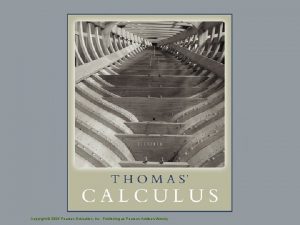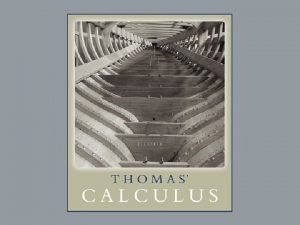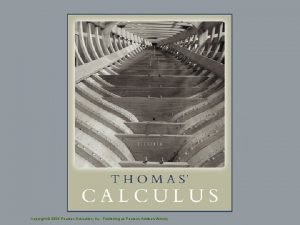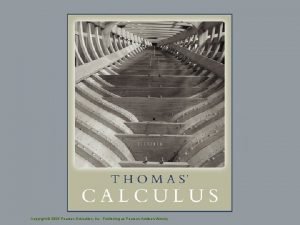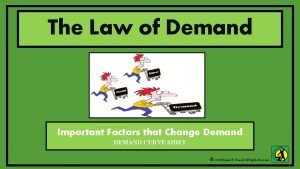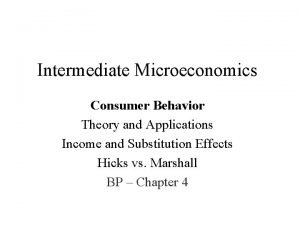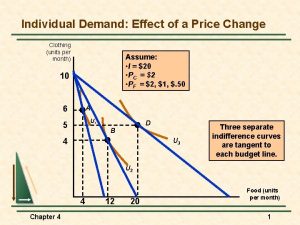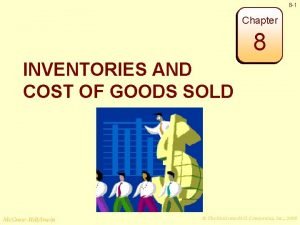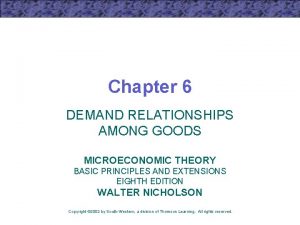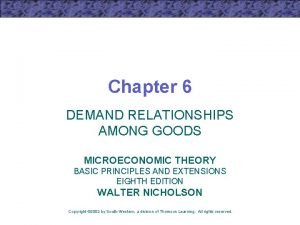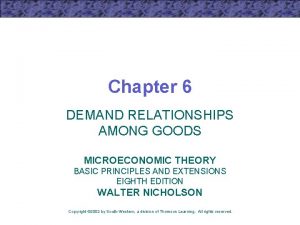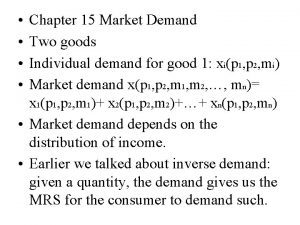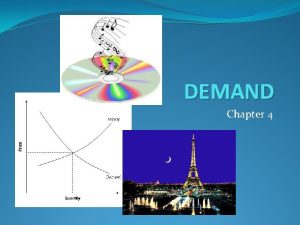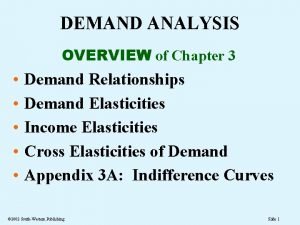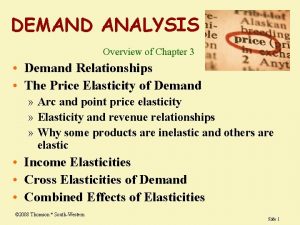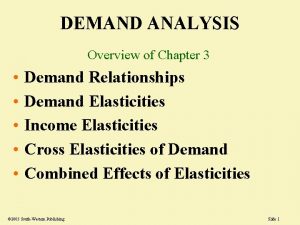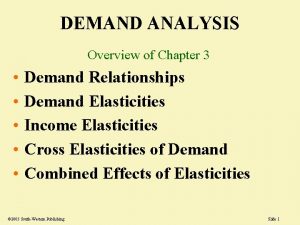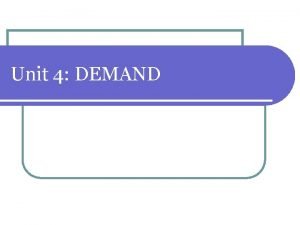Chapter 6 DEMAND RELATIONSHIPS AMONG GOODS Copyright 2005















































- Slides: 47

Chapter 6 DEMAND RELATIONSHIPS AMONG GOODS Copyright © 2005 by South-Western, a division of Thomson Learning. All rights reserved. 1

The Two-Good Case • The types of relationships that can occur when there are only two goods are limited • But this case can be illustrated with twodimensional graphs 2

Gross Complements Quantity of y When the price of y falls, the substitution effect may be so small that the consumer purchases more x and more y In this case, we call x and y gross complements y 1 y 0 U 0 x 1 U 1 x/ py < 0 Quantity of x 3

Gross Substitutes Quantity of y When the price of y falls, the substitution effect may be so large that the consumer purchases less x and more y In this case, we call x and y gross substitutes y 1 y 0 U 1 x/ py > 0 U 0 x 1 x 0 Quantity of x 4

A Mathematical Treatment • The change in x caused by changes in py can be shown by a Slutsky-type equation substitution effect (+) income effect (-) if x is normal combined effect (ambiguous) 5

Substitutes and Complements • For the case of many goods, we can generalize the Slutsky analysis for any i or j – this implies that the change in the price of any good induces income and substitution effects that may change the quantity of every good demanded 6

Substitutes and Complements • Two goods are substitutes if one good may replace the other in use – examples: tea & coffee, butter & margarine • Two goods are complements if they are used together – examples: coffee & cream, fish & chips 7

Gross Substitutes and Complements • The concepts of gross substitutes and complements include both substitution and income effects – two goods are gross substitutes if xi / pj > 0 – two goods are gross complements if xi / pj < 0 8

Asymmetry of the Gross Definitions • One undesirable characteristic of the gross definitions of substitutes and complements is that they are not symmetric • It is possible for x 1 to be a substitute for x 2 and at the same time for x 2 to be a complement of x 1 9

Asymmetry of the Gross Definitions • Suppose that the utility function for two goods is given by U(x, y) = ln x + y • Setting up the Lagrangian L = ln x + y + (I – pxx – pyy) 10

Asymmetry of the Gross Definitions gives us the following first-order conditions: L/ x = 1/x - px = 0 L/ y = 1 - py = 0 L/ = I - pxx - pyy = 0 • Manipulating the first two equations, we get pxx = py 11

Asymmetry of the Gross Definitions • Inserting this into the budget constraint, we can find the Marshallian demand for y pyy = I – py – an increase in py causes a decline in spending on y • since px and I are unchanged, spending on x must rise ( x and y are gross substitutes) • but spending on y is independent of px ( x and y are independent of one another) 12

Net Substitutes and Complements • The concepts of net substitutes and complements focuses solely on substitution effects – two goods are net substitutes if – two goods are net complements if 13

Net Substitutes and Complements • This definition looks only at the shape of the indifference curve • This definition is unambiguous because the definitions are perfectly symmetric 14

Gross Complements Even though x and y are gross complements, they are net substitutes Quantity of y y 1 y 0 U 0 x 1 U 1 Since MRS is diminishing, the own-price substitution effect must be negative so the cross-price substitution effect must be positive Quantity of x 15

Substitutability with Many Goods • Once the utility-maximizing model is extended to may goods, a wide variety of demand patterns become possible • According to Hicks’ second law of demand, “most” goods must be substitutes 16

Substitutability with Many Goods • To prove this, we can start with the compensated demand function xc(p 1, …pn, V) • Applying Euler’s theorem yields 17

Substitutability with Many Goods • In elasticity terms, we get • Since the negativity of the substitution effect implies that eiic 0, it must be the case that 18

Composite Commodities • In the most general case, an individual who consumes n goods will have demand functions that reflect n(n+1)/2 different substitution effects • It is often convenient to group goods into larger aggregates – examples: food, clothing, “all other goods” 19

Composite Commodity Theorem • Suppose that consumers choose among n goods • The demand for x 1 will depend on the prices of the other n-1 commodities • If all of these prices move together, it may make sense to lump them into a single composite commodity (y) 20

Composite Commodity Theorem • Let p 20…pn 0 represent the initial prices of these other commodities – assume that they all vary together (so that the relative prices of x 2…xn do not change) • Define the composite commodity y to be total expenditures on x 2…xn at the initial prices y = p 20 x 2 + p 30 x 3 +…+ pn 0 xn 21

Composite Commodity Theorem • The individual’s budget constraint is I = p 1 x 1 + p 20 x 2 +…+ pn 0 xn = p 1 x 1 + y • If we assume that all of the prices p 20…pn 0 change by the same factor (t > 0) then the budget constraint becomes I = p 1 x 1 + tp 20 x 2 +…+ tpn 0 xn = p 1 x 1 + ty – changes in p 1 or t induce substitution effects 22

Composite Commodity Theorem • As long as p 20…pn 0 move together, we can confine our examination of demand to choices between buying x 1 and “everything else” • The theorem makes no prediction about how choices of x 2…xn behave – only focuses on total spending on x 2…xn 23

Composite Commodity • A composite commodity is a group of goods for which all prices move together • These goods can be treated as a single commodity – the individual behaves as if he is choosing between other goods and spending on this entire composite group 24

Example: Composite Commodity • Suppose that an individual receives utility from three goods: – food (x) – housing services (y), measured in hundreds of square feet – household operations (z), measured by electricity use • Assume a CES utility function 25

Example: Composite Commodity • The Lagrangian technique can be used to derive demand functions 26

Example: Composite Commodity • If initially I = 100, px = 1, py = 4, and pz = 1, then • x* = 25, y* = 12. 5, z* = 25 – $25 is spent on food and $75 is spent on housing-related needs 27

Example: Composite Commodity • If we assume that the prices of housing services (py) and electricity (pz) move together, we can use their initial prices to define the “composite commodity” housing (h) h = 4 y + 1 z • The initial quantity of housing is the total spent on housing (75) 28

Example: Composite Commodity • Now x can be shown as a function of I, px, and ph • If I = 100, px = 1, py = 4, and ph = 1, then x* = 25 and spending on housing (h*) = 75 29

Example: Composite Commodity • If py rises to 16 and pz rises to 4 (with px remaining at 1), ph would also rise to 4 • The demand for x would fall to • Housing purchases would be given by 30

Example: Composite Commodity • Since ph = 4, h* = 150/7 • If I = 100, px = 1, py = 16, and pz = 4, the individual demand functions show that x* = 100/7, y* = 100/28, z* = 100/14 • This means that the amount of h that is consumed can also be computed as h* = 4 y* + 1 z* = 150/7 31

Household Production Model • Assume that individuals do not receive utility directly from the goods they purchase in the market • Utility is received when the individual produces goods by combining market goods with time inputs – raw beef and uncooked potatoes yield no utility until they are cooked together to produce stew 32

Household Production Model • Assume that there are three goods that a person might want to purchase in the market: x, y, and z – these goods provide no direct utility – these goods can be combined by the individual to produce either of two homeproduced goods: a 1 or a 2 • the technology of this household production can be represented by a production function 33

Household Production Model • The individual’s goal is to choose x, y, and z so as to maximize utility = U(a 1, a 2) subject to the production functions a 1 = f 1(x, y, z) a 2 = f 2(x, y, z) and a financial budget constraint pxx + pyy + pzz = I 34

Household Production Model • Two important insights from this general model can be drawn – because the production functions are measurable, households can be treated as “multi-product” firms – because consuming more a 1 requires more use of x, y, and z, this activity has an opportunity cost in terms of the amount of a 2 that can be produced 35

The Linear Attributes Model • In this model, it is the attributes of goods that provide utility to individuals • Each good has a fixed set of attributes • The model assumes that the production equations for a 1 and a 2 have the form a 1 = ax 1 x + ay 1 y + az 1 z a 2 = ax 2 x + ay 2 y + az 2 z 36

The Linear Attributes Model The ray 0 x shows the combinations of a 1 and a 2 available from successively larger amounts of good x a 2 x y The ray 0 y shows the combinations of a 1 and a 2 available from successively larger amounts of good y z 0 The ray 0 z shows the combinations of a 1 and a 2 available from successively larger amounts of good z a 1 37

The Linear Attributes Model • If the individual spends all of his or her income on good x x* = I/px • That will yield a 1* = ax 1 x* = (ax 1 I)/px a 2* = ax 2 x* = (ax 2 I)/px 38

The Linear Attributes Model x* is the combination of a 1 and a 2 that would be obtained if all income was spent on x a 2 x y x* y* is the combination of a 1 and a 2 that would be obtained if all income was spent on y y* z z* is the combination of a 1 and a 2 that would be obtained if all income was spent on z Z* 0 a 1 39

The Linear Attributes Model All possible combinations from mixing the three market goods are represented by the shaded triangular area x*y*z* a 2 x y x* y* z z* 0 a 1 40

The Linear Attributes Model A utility-maximizing individual would never consume positive quantities of all three goods a 2 x Individuals with a preference toward a 1 will have indifference curves similar to U 0 and will consume only y and z y U 1 U 0 0 z Individuals with a preference toward a 0 will have indifference curves similar to U 1 and will consume only x and y a 1 41

The Linear Attributes Model • The model predicts that corner solutions (where individuals consume zero amounts of some commodities) will be relatively common – especially in cases where individuals attach value to fewer attributes than there are market goods to choose from • Consumption patterns may change abruptly if income, prices, or preferences change 42

Important Points to Note: • When there are only two goods, the income and substitution effects from the change in the price of one good (py) on the demand for another good (x) usually work in opposite directions – the sign of x/ py is ambiguous • the substitution effect is positive • the income effect is negative 43

Important Points to Note: • In cases of more than two goods, demand relationships can be specified in two ways – two goods are gross substitutes if xi / pj > 0 and gross complements if xi / pj < 0 – because these price effects include income effects, they may not be symmetric • it is possible that xi / pj xj / pi 44

Important Points to Note: • Focusing only on the substitution effects from price changes does provide a symmetric definition – two goods are net substitutes if xi c/ pj > 0 and net complements if xi c/ pj < 0 – because xic / pj = xjc / pi, there is no ambiguity – Hicks’ second law of demand shows that net substitutes are more prevalent 45

Important Points to Note: • If a group of goods has prices that always move in unison, expenditures on these goods can be treated as a “composite commodity” whose “price” is given by the size of the proportional change in the composite goods’ prices 46

Important Points to Note: • An alternative way to develop theory of choice among market goods is to focus on the ways in which market goods are used in household production to yield utility-providing attributes – this may provide additional insights into relationships among goods 47
 Demand relationships among goods
Demand relationships among goods Convenience goods shopping goods specialty goods
Convenience goods shopping goods specialty goods Copyright 2005
Copyright 2005 Copyright 2005
Copyright 2005 2005 pearson prentice hall inc
2005 pearson prentice hall inc Copyright 2005
Copyright 2005 Copyright 2005
Copyright 2005 Copyright 2005
Copyright 2005 Copyright 2005
Copyright 2005 Pearson
Pearson Copyright 2005
Copyright 2005 Copyright 2005
Copyright 2005 Progressive tax
Progressive tax Positive consumption externality
Positive consumption externality Public goods dan private goods adalah
Public goods dan private goods adalah Periodic relationships among the elements
Periodic relationships among the elements Periodic relationships among the elements
Periodic relationships among the elements Vsdfds
Vsdfds Periodic relationships
Periodic relationships Demand for complementary goods
Demand for complementary goods Public goods demand curve
Public goods demand curve Diminishing marginal rate of substitution
Diminishing marginal rate of substitution Individual demand for fashion goods is affected by
Individual demand for fashion goods is affected by Deterministic demand vs stochastic demand
Deterministic demand vs stochastic demand Measures to correct excess demand and deficient demand
Measures to correct excess demand and deficient demand Individual demand vs market demand
Individual demand vs market demand Demand dependent inventory
Demand dependent inventory Ang demand function
Ang demand function Dependent demand vs independent demand
Dependent demand vs independent demand Module 5 supply and demand introduction and demand
Module 5 supply and demand introduction and demand Demand estimation and demand forecasting
Demand estimation and demand forecasting Distinguish between individual demand and market demand
Distinguish between individual demand and market demand Inventory planning for independent demand items
Inventory planning for independent demand items Competition among businesses
Competition among businesses Among the hidden chapter 4
Among the hidden chapter 4 Competition among businesses
Competition among businesses Design of goods and services in operations management pdf
Design of goods and services in operations management pdf Chapter 8 inventories and the cost of goods sold
Chapter 8 inventories and the cost of goods sold Chapter 7 lesson 1 healthy family relationships
Chapter 7 lesson 1 healthy family relationships Chapter 8 peer relationships
Chapter 8 peer relationships Chapter 7 lesson 1 healthy family relationships answer key
Chapter 7 lesson 1 healthy family relationships answer key Chapter 2 principles of ecology
Chapter 2 principles of ecology Principles of ecology section 2 flow of energy
Principles of ecology section 2 flow of energy Section 1 organisms and their relationships
Section 1 organisms and their relationships Principles of ecology chapter 2 section 1 answer key
Principles of ecology chapter 2 section 1 answer key Chapter 8 healthy peer relationships
Chapter 8 healthy peer relationships Chapter 6 lesson 1 foundations of a healthy relationship
Chapter 6 lesson 1 foundations of a healthy relationship Close family chapter 5
Close family chapter 5


